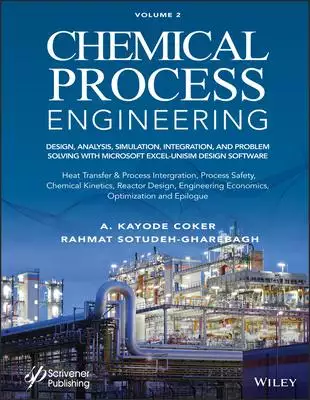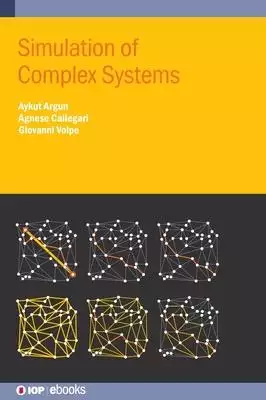Hands-On simulation 的問題,透過圖書和論文來找解法和答案更準確安心。 我們找到下列訂位、菜單、價格優惠和問答集
Hands-On simulation 的問題,我們搜遍了碩博士論文和台灣出版的書籍,推薦寫的 Chemical Process Engineering: Design, Analysis, Simulation, Integration, and Problem Solving with Microsoft Excel-Unisim Softwar 和Volpe, Giovanni,Callegari, Agnese,Argun, Aykut的 Simulation of Complex Systems都 可以從中找到所需的評價。
這兩本書分別來自 和所出版 。
國立臺灣師範大學 科學教育研究所 陳素芬、顏妙璇所指導 王宏軒的 電腦模擬教學和後設認知鷹架對高中生光學學習表現的影響 (2021),提出Hands-On simulation 關鍵因素是什麼,來自於電腦輔助學習、後設認知監控、後設認知鷹架、光學學習、科學探究。
而第二篇論文亞洲大學 經營管理學系 曾明朗、陳志成所指導 陽朗迪的 印尼食品和飲料行業的可持續回收包裝:消費階段的混合決策分析 (2021),提出因為有 可持續包裝、消費過程、保護能力、環境交流、成本考慮、Choquet積分、模糊決策試驗評價實驗室的重點而找出了 Hands-On simulation 的解答。
Chemical Process Engineering: Design, Analysis, Simulation, Integration, and Problem Solving with Microsoft Excel-Unisim Softwar

為了解決Hands-On simulation 的問題,作者 這樣論述:
CHEMICAL PROCESS ENGINEERINGWritten by one of the most prolific and respected chemical engineers in the world and his co-author, also a well-known and respected engineer, this two-volume set is the "new standard" in the industry, offering engineers and students alike the most up-do-date, comprehe
nsive, and state-of-the-art coverage of processes and best practices in the field today. This new two-volume set explores and describes integrating new tools for engineering education and practice for better utilization of the existing knowledge on process design. Useful not only for students, unive
rsity professors, and practitioners, especially process, chemical, mechanical and metallurgical engineers, it is also a valuable reference for other engineers, consultants, technicians and scientists concerned about various aspects of industrial design. The text can be considered as complementary to
process design for senior and graduate students as well as a hands-on reference work or refresher for engineers at entry level. The contents of the book can also be taught in intensive workshops in the oil, gas, petrochemical, biochemical and process industries. The book provides a detailed descrip
tion and hands-on experience on process design in chemical engineering, and it is an integrated text that focuses on practical design with new tools, such as Microsoft Excel spreadsheets and UniSim simulation software. Written by two of the industry’s most trustworthy and well-known authors, this bo
ok is the new standard in chemical, biochemical, pharmaceutical, petrochemical and petroleum refining. Covering design, analysis, simulation, integration, and, perhaps most importantly, the practical application of Microsoft Excel-UniSim software, this is the most comprehensive and up-to-date covera
ge of all of the latest developments in the industry. It is a must-have for any engineer or student’s library.
Hands-On simulation 進入發燒排行的影片
(00:57) 主要SPECS
(04:42)close up(hands on)
(10:23)lose up(hands on)
(10:23)論相
(17:54) film simulation
(20:46)結論
如果欣賞我們《膠攝現場》請Bookmark、訂閱及Like我們的網站、Youtube頻道同facebook Page啦!
網站:https://plasticphoto.hk
Youtube:https://www.youtube.com/plasticphoto
facebook:https://www.facebook.com/plasticphoto/
主持人個人專頁
Brian: https://www.facebook.com/ngbrian9527/
Joey: https://www.facebook.com/joeypongpage/
Joey IG: https://www.instagram.com/joeypong/
Colin IG: https://www.instagram.com
Colin: https://www.facebook.com/pklamfoto/
Karhoo: https://www.facebook.com/chowkarhoofans
Karhoo IG 1: https://www.instagram.com/chowkarhoop...
Karhoo IG 2: https://www.instagram.com/karhoofilm
Karhoo web: http://www.chowkarhoo.com
電腦模擬教學和後設認知鷹架對高中生光學學習表現的影響
為了解決Hands-On simulation 的問題,作者王宏軒 這樣論述:
光學在學習和教學中都是一個具有挑戰性的主題,其抽象的概念和對科學模型的錯誤理解是造成學生光學學習困難的重要因素。科學教育學者建議電腦模擬可以促進學生的學習表現,因此我們進行兩項研究來了解電腦模擬的學習環境如何影響學生的概念理解、後設認知監控準確性及改善探究能力。研究一的目的在調查發光射線模型和電腦模擬對學生概念理解和後設認知監控準確性的影響效果。三個高一班級的學生參加了研究一的實驗,其中一個班級(n = 34)參與傳統射線模型的講授課程,另一個班級(n = 33)參與發光射線模型的講授課程,第三個班級(n = 37)則參與電腦模擬結合發光射線模型的課程。透過使用選擇題的前測與後測來比較三個班
級學生的概念理解及對概念理解的後設認知監控準確性。研究一的結果顯示發光射線模型改善學生的概念理解,而電腦模擬則有助於提高學生在概念理解的後設認知監控準確性。此外,電腦模擬透過提供3D結構的成像之獨特性促進學生光學概念的理解。研究二的目的是調查引入後設認知鷹架對學生在電腦模擬的環境中進行探究任務之影響。兩個高三班級的學生參加了這項研究,其中一個班級 (n = 33) 參與後設認知鷹架融入電腦模擬的探究課程,另一個班級 (n = 34) 則參與僅有電腦模擬支持的探究課程。透過使用選擇題的前測與後測及學習過程中的學習單來比較兩個班級學生的概念理解、探究思考技能(控制變因策略、數據解釋和圖形理解)、後
設認知監控準確性和探究活動的表現。研究二的結果顯示使用不同學習方法之兩個班級的學生,其概念理解和對概念理解的後設認知監控準確性,後測均較前測顯著改善,而將後設認知鷹架融入電腦模擬的探究學習活動則可以改善探究思考技能及對此技能的後設認知監控;特別是在較複雜的探究任務中,引入後設認知鷹架對學習效果的改善更是顯著。這些發現將有助於科學教師發展最佳教學模組來促進學生的光學學習。
Simulation of Complex Systems

為了解決Hands-On simulation 的問題,作者Volpe, Giovanni,Callegari, Agnese,Argun, Aykut 這樣論述:
This book deals with the most fundamental and essential techniques to simulate complex systems, from the dynamics of molecules to the spreading of diseases, from optimization using ant colonies to the simulation of the Game of Life.Several natural systems found in physics, biology and engineering
can be considered complex systems, because their behaviour is not easily predictable and is the result of complex interactions among their constituents. Examples of complex systems are a cell with its organelles, an organ, the human brain, social networks, transportation and communication systems,
the stock market, ecosystems, systems with prey and predators, a swarm of bees.There are several specialized books focusing on different simulation methods, but there is not one fully devoted to complex systems. The "bottom-up" approach is innovative and allows the reader to conduct numerical experi
ments to explore the system’s behaviour.Key Features: Composed of self-contained, independent chaptersIllustrates simulation techniques in a broad range of fields from physics and biology to engineering, social science and economicsProvides a hands-on approach with guided exercisesCovers the fundame
ntal numerical techniques in complex systemsIdeal for self-studyContains supplementary example codes and video tutorials
印尼食品和飲料行業的可持續回收包裝:消費階段的混合決策分析
為了解決Hands-On simulation 的問題,作者陽朗迪 這樣論述:
本研究為印度尼西亞的食品和飲料可持續包裝以及包裝產品的消費前、消費中、消費後階段建立了一個有效的理論模型。食品和飲料產品包裝由於回收率慢和回收物供應量低而在總廢物成分中占主導地位,並且包裝往往在消費後階段被亂扔垃圾。本研究旨在解決可持續包裝屬性,並了解哪個消費階段需要優先改進。採用混合法,模糊德爾菲法是對屬性進行剔除和驗證。使用模糊決策試驗和評估實驗室檢查和可視化屬性之間的相互關係。優先消費階段通過Choquet積分法確定。結果表明,消費後階段的根本目的是解決可持續包裝問題。本研究發現,保護能力、環境交流和成本考慮是改善可持續包裝的驅動因素。對於實踐,最高標準被確定為包裝回收、多方利益相關者
互動、廢物處置基礎設施、廢物收集基礎設施和廢物處置管理。